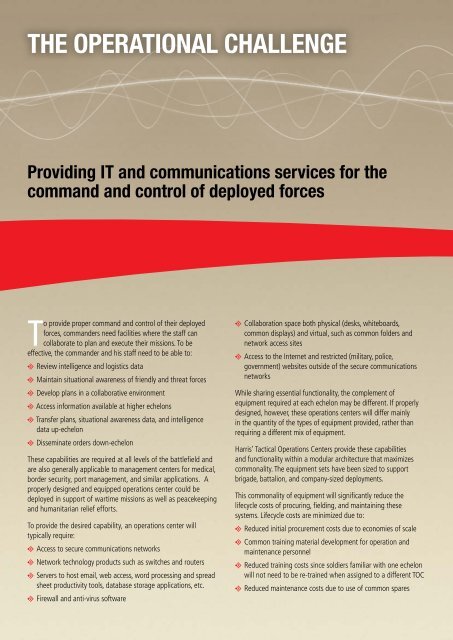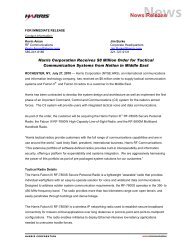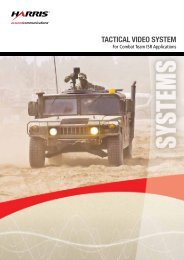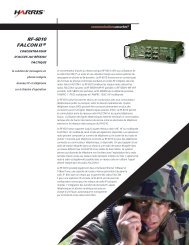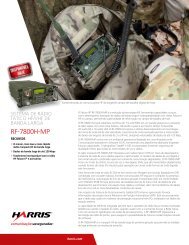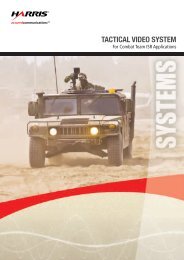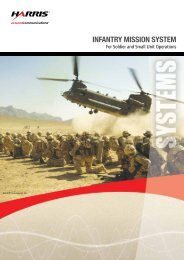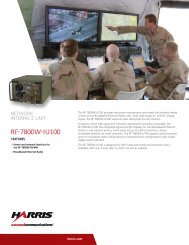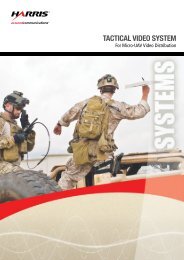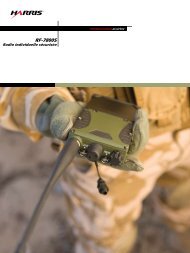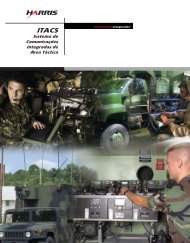For Tactical Operations Centers - Harris RF Communications ...
For Tactical Operations Centers - Harris RF Communications ...
For Tactical Operations Centers - Harris RF Communications ...
You also want an ePaper? Increase the reach of your titles
YUMPU automatically turns print PDFs into web optimized ePapers that Google loves.
THE OPERATIONAL challenge<br />
Providing IT and communications services for the<br />
command and control of deployed forces<br />
To provide proper command and control of their deployed<br />
forces, commanders need facilities where the staff can<br />
collaborate to plan and execute their missions. To be<br />
effective, the commander and his staff need to be able to:<br />
l Review intelligence and logistics data<br />
l Maintain situational awareness of friendly and threat forces<br />
l Develop plans in a collaborative environment<br />
l Access information available at higher echelons<br />
l Transfer plans, situational awareness data, and intelligence<br />
data up-echelon<br />
l Disseminate orders down-echelon<br />
These capabilities are required at all levels of the battlefield and<br />
are also generally applicable to management centers for medical,<br />
border security, port management, and similar applications. A<br />
properly designed and equipped operations center could be<br />
deployed in support of wartime missions as well as peacekeeping<br />
and humanitarian relief efforts.<br />
To provide the desired capability, an operations center will<br />
typically require:<br />
l Access to secure communications networks<br />
l Network technology products such as switches and routers<br />
l Servers to host email, web access, word processing and spread<br />
sheet productivity tools, database storage applications, etc.<br />
l Firewall and anti-virus software<br />
l Collaboration space both physical (desks, whiteboards,<br />
common displays) and virtual, such as common folders and<br />
network access sites<br />
l Access to the Internet and restricted (military, police,<br />
government) websites outside of the secure communications<br />
networks<br />
While sharing essential functionality, the complement of<br />
equipment required at each echelon may be different. If properly<br />
designed, however, these operations centers will differ mainly<br />
in the quantity of the types of equipment provided, rather than<br />
requiring a different mix of equipment.<br />
<strong>Harris</strong>’ <strong>Tactical</strong> <strong>Operations</strong> <strong>Centers</strong> provide these capabilities<br />
and functionality within a modular architecture that maximizes<br />
commonality. The equipment sets have been sized to support<br />
brigade, battalion, and company-sized deployments.<br />
This commonality of equipment will significantly reduce the<br />
lifecycle costs of procuring, fielding, and maintaining these<br />
systems. Lifecycle costs are minimized due to:<br />
l Reduced initial procurement costs due to economies of scale<br />
l Common training material development for operation and<br />
maintenance personnel<br />
l Reduced training costs since soldiers familiar with one echelon<br />
will not need to be re-trained when assigned to a different TOC<br />
l Reduced maintenance costs due to use of common spares


